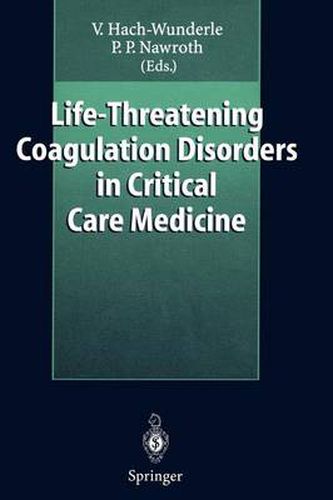Readings Newsletter
Become a Readings Member to make your shopping experience even easier.
Sign in or sign up for free!
You’re not far away from qualifying for FREE standard shipping within Australia
You’ve qualified for FREE standard shipping within Australia
The cart is loading…






This title is printed to order. This book may have been self-published. If so, we cannot guarantee the quality of the content. In the main most books will have gone through the editing process however some may not. We therefore suggest that you be aware of this before ordering this book. If in doubt check either the author or publisher’s details as we are unable to accept any returns unless they are faulty. Please contact us if you have any questions.
Hypercoagulability and bleeding are problems physicians frequently encounter when treating intensive care patients. The coagulation mechanism is a tightly controlled system. Its balance is disturbed in conditions such as septicemia, trauma, shock, and others. The dis turbances may be local or disseminated and the therapeutic options available are limited and nonspecific: limited since in most cir cumstances they may not affect the underlying disease and are si milarly independent of the pathogenic mechanism; nonspecific since they cannot be specifically targeted to the problem of local or sys temic disturbance of coagulation. Furthermore, increased and de creased coagulability may be present at the same time. Activation of coagulation may lead to fibrin deposition and decreased hemostatic capacity, as seen in disseminated intravascular coagulation. New diagnostic approaches for acquired disorders of coagulation have been developed and form a new basis for therapeutic strategies. Despite this progress, many physicians are aware of the problem that, especially for intensive care patients, a treatment very often has to be selected before diagnostic procedures can be completed. We also know that for many diseases rare occurrence or the hetero genity of the patient population make it quite difficult to conduct clinical studies which prove that a therapeutic regimen is efficacious. Thus, much discussion about coagulation disorders in critically ill patients is still necessary. Even so, it is important to provide guidelines for handling these problems.
$9.00 standard shipping within Australia
FREE standard shipping within Australia for orders over $100.00
Express & International shipping calculated at checkout
This title is printed to order. This book may have been self-published. If so, we cannot guarantee the quality of the content. In the main most books will have gone through the editing process however some may not. We therefore suggest that you be aware of this before ordering this book. If in doubt check either the author or publisher’s details as we are unable to accept any returns unless they are faulty. Please contact us if you have any questions.
Hypercoagulability and bleeding are problems physicians frequently encounter when treating intensive care patients. The coagulation mechanism is a tightly controlled system. Its balance is disturbed in conditions such as septicemia, trauma, shock, and others. The dis turbances may be local or disseminated and the therapeutic options available are limited and nonspecific: limited since in most cir cumstances they may not affect the underlying disease and are si milarly independent of the pathogenic mechanism; nonspecific since they cannot be specifically targeted to the problem of local or sys temic disturbance of coagulation. Furthermore, increased and de creased coagulability may be present at the same time. Activation of coagulation may lead to fibrin deposition and decreased hemostatic capacity, as seen in disseminated intravascular coagulation. New diagnostic approaches for acquired disorders of coagulation have been developed and form a new basis for therapeutic strategies. Despite this progress, many physicians are aware of the problem that, especially for intensive care patients, a treatment very often has to be selected before diagnostic procedures can be completed. We also know that for many diseases rare occurrence or the hetero genity of the patient population make it quite difficult to conduct clinical studies which prove that a therapeutic regimen is efficacious. Thus, much discussion about coagulation disorders in critically ill patients is still necessary. Even so, it is important to provide guidelines for handling these problems.